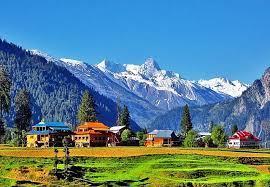Whether you’re a couple planning their honeymoon, a family planning their holidays, or a group of friends planning the best gateway from the hustle and bustle of life; Kashmir is the place to be.
Over 6000 feet above sea level, with its hilly areas and mountainous icecaps higher above the sea-level, Kashmir offers everything from trekking or ice-trekking depending on the season, its beautiful greens and flowery hills, and the most popular feature of Kashmir, its high-altitude lakes.
The Great Lakes of Kashmir
Among the popular lakes of Kashmir are Dal Lake, Nigeen Lake, Gadsar Lake, Wular Lake, Gngabal, Manasbal Lake, Vishansar Lake, and more.
The first thing that tourists usually picture when they think of Kashmir, is Dal Lake. Right adjacent to the Dal Lake is another popular and significant lake, the Nigeen Lake.
While Dal Lake is usually filled with tourists around the year, Nigeen Lake is far less popular but is also starting to be popularised by tourists.
Dal Lake - The Jewel of Srinagar
The Dal Lake, also known as the "Jewel of Srinagar," is one of the several reasons visitors are drawn to the city. Dal Jheel, or lake, is the second-biggest lake in the state and is regarded as the most picturesque. It has a radius of around fifteen kilometers.
This lake is interesting in that it includes a lot of complex waterways and canals that beautifully interact with each other, as well as five basins.
During the peak winter seasons of December and January, Dal Lake freezes to an almost frozen to a completely frozen state. Officials and locals alike are observed skiing instead of boating across the lake because of this.
Shikara or small boating activities stop during this time. It usually occurs during the beginning of January and lasts till the end of winter.
During early winter as well as spring, tourists can experience the true beauty of this lake with shikara rides and houseboat stays.
Wular Lake - Asia's Largest Freshwater Lake
Asia’s largest freshwater lake, Lake Wular is in the Kashmir Valley 40 km northwest of Srinagar City.
Wular Lake is one of the biggest freshwater lakes in Asia, and part of the magnificent lakes of Kashmir. Spanning 189+ square kilometres. The lake is located 1,580+ meters above sea level. It is 16 km long, it is important for fishing and birds, and many migrating waterfowl species use it as a viable wintering place. Wular Lake provides 59% of the Kashmir Valley's fish production and is a significant fish habitat.
Wular Lake is crucial to the hydrographic system of the Kashmir Valley because it acts as a sizable absorption basin for annual floodwater.
Manasbal Lake - The Birdwatcher's Paradise
One of Srinagar's most popular tourist destinations is Manasbal Lake, which is often referred to as a birdwatcher's paradise. Mansabal Lake in Srinagar is around thirty kilometers north of the city. Jarokbal, Kondabal, and Gratbal are the three towns that surround the lake, which is breathtaking.
The lake, which is the deepest in the Kashmir Valley, is made even more stunning by the lovely lotuses that surround it. Although the history of this old lake is still unknown, it is rumored to be a bottomless lake.
Remnants of a fort constructed in the 17th century by a Mughal emperor at the northern edge of Manasbal Lake in Srinagar still exist.
The eastern portion of the lake is mostly mountainous, while the northern portion is made up of a high plateau called "Karewa" that has layers of loess, lacustrine, and fluviatile materials.
Trekking to High-Altitude Lakes
Out of some of the high-altitude lakes of Kashmir are Kishansar and Vishnasar.
These two lakes are remarkably situated in the Pirpanjal range and are part of the 65-kilometer walk from Shakdur to Naranag. The elevation of the lakes is over 14,000 feet.
Because Kishansar and Vishansar are situated close to one another and beneath the slopes of Gadsar Pass, the upward journey to Gadsar is both incredibly magnificent and scary.
Camping is permitted along the banks of a stream that empties into Kishansar and Vishansar lakes. You will be haunted by the valley's captivating beauty for a long time.
The lake's water is greenish in color and very cold.
Swastik Tours offers a range of itinerary options for Kashmir, including high-altitude lake treks and exploring other grandeur of Kashmir. The Great Lakes of Kashmir are only a few of the many marvels we cover.
To trek to high-altitude lakes, tour services may include cab transfers, meals, tents, cooks or chefs, tents for toilets, first aid kits and helpers, assistance for hiking, and camping gear, among other facilities.
The Enchanting Beauty of Sheeshnag Lake
Sheshnag Lake is located over 16 to 17 km from Pahalgam at an altitude of more than 3.9k meters.
High-altitude Sheshnag Lake is encircled by towering mountains and glaciers. The glaciers that melt provide Sheshnag Lake with all its water.
The Sheshnag Lake hike is a moderately difficult hike with some challenging portions. You may enjoy beautiful views of the rugged landscape and mountains during the trip.
This area is home to the Lidder River, a significant river that will accompany you on your journey. You will likely see Hindu pilgrims on the Amarnath Yatra route. Out of the many lakes of Kashmir, Sheshnag Lake prides itself on being one of the clearest lakes.
Conservation and Environmental Challenges
Global Warming has been an environmental challenge across the globe, with greenhouse gases and CO2 emissions at an all-time high since the start of the industrial revolution.
Naturally dense with natural trees and waterbodies, Kashmir is also part of the environmental challenges that pose a threat to its natural resources and beauty.
Kashmir Valley and its Glaciers, namely Jhelum Basin, along with Kolahoi Glacier, are melting fast. Water levels rise fast because of this. Additionally, deforestation is also contributing to global warming rapidly.
Conservation efforts in this union territory are ongoing. Trees, forest bodies, and water bodies are all protected under the government's many policies and regulations. Unfortunately, pollution across the globe will continue to affect the glaciers melting which may affect the great valleys of Kashmir.





